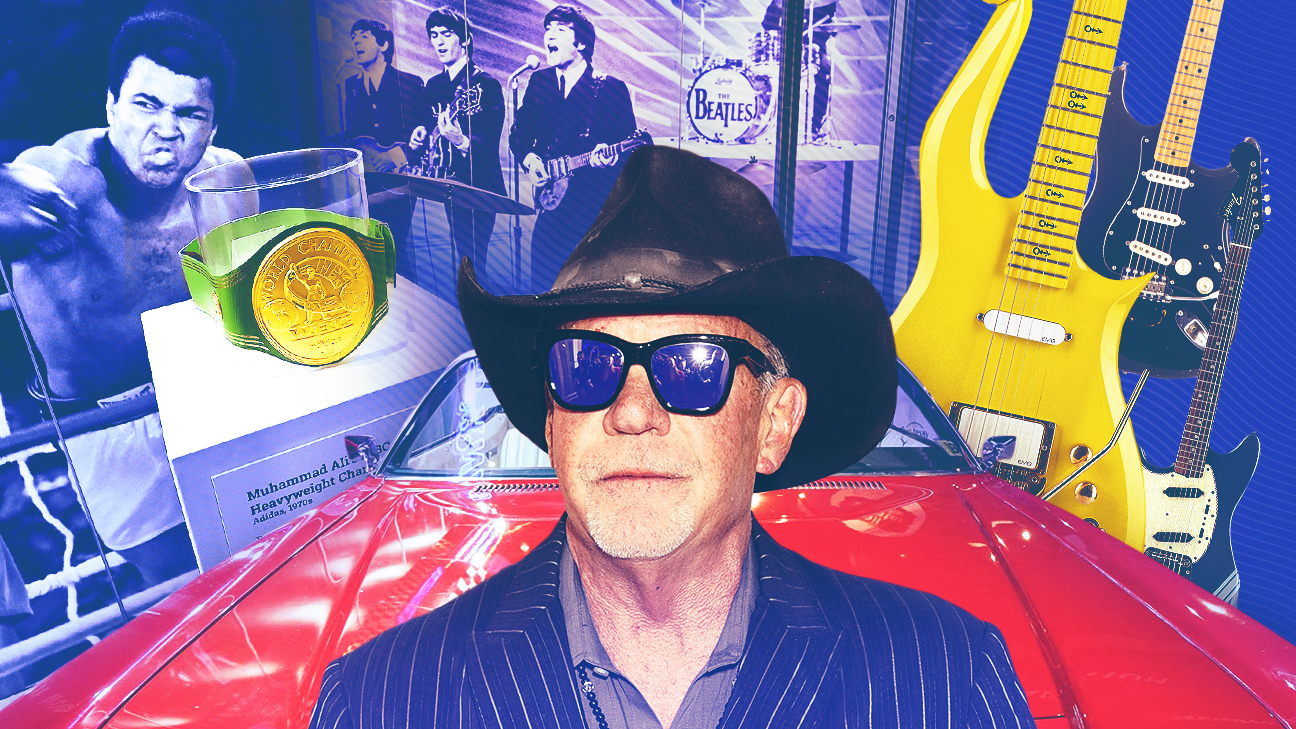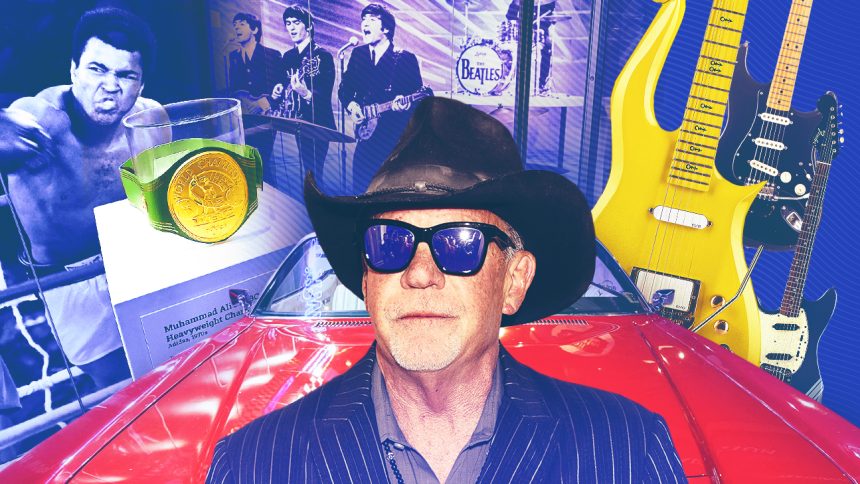
INDIANAPOLIS — As the clock ticked past midnight on the evening of July 23, 2022, Indianapolis Colts owner Jim Irsay found himself in something of a sudden-death scenario.
Even after his decades-long association with the NFL, this was a nail-biter unlike any Irsay had ever experienced.
Irsay and another persistent bidder were squaring off in a virtual auction in pursuit of one of the most revered pieces of sports memorabilia. It became apparent that landing Muhammad Ali’s “Rumble in the Jungle” championship belt, from his 1974 victory over George Foreman in Zaire, would be a stressful endeavor.
Back and forth they went, Irsay and his anonymous nemesis, one-upping each other with every bid. Late evening morphed into early morning, and still, the bidding persisted. Finally, after 4 a.m., the bidding war lasting more than five hours was over.
Irsay’s winning bid? A cool $6.18 million.
“Ali’s the greatest athlete that ever lived,” Irsay said. “And his greatest moment was in Zaire. No one thought he could beat Foreman.”
Irsay is widely known as one of the NFL’s more influential and outspoken team owners. But he is also gaining a reputation for owning one of the world’s most eclectic collections of historic artifacts, ranging from sports to pop culture to literature to American history.
The Ali purchase is emblematic of the high bar when deciding what items make the cut for the nearly 500-piece Jim Irsay Collection. The collection will next be displayed at TD Garden in Boston on Saturday, the latest in a series of traveling exhibitions and concerts Irsay opens to the public for free.
The objective is not to pursue items that are merely expensive, though numerous items in the collection were acquired for several million dollars (among them Pink Floyd guitarist David Gilmour’s $3.9 million “Black Strat”). It’s also not enough that an item simply be rare.
Rather, Irsay seeks items of significance that are tied to seminal moments, the kind that occur once in a lifetime.
“I’ve pondered questions such as what real currency does a memory have,” Irsay said. “How did the memory serve us? Did it help form who you are? There are historic moments that shifted the whole world. History is just an incredible teacher for us.”
This focus can be seen throughout the collection.
The Beatles bass drum used by Ringo Starr on “The Ed Sullivan Show” in 1964, introducing the British band to the American public, certainly qualifies (price: $2 million).
Irsay’s more-than-200-year-old copy of the Declaration of Independence does, too (Side note: Irsay asked former President Barack Obama to sign the document, but Obama felt unworthy and agreed to include a letter instead).
The saddle used by jockey Ron Turcotte to ride Secretariat into the history books — with a 31-length, Triple Crown-winning victory at the 1973 Belmont Stakes — obviously belongs in the collection. That’s why it is among Irsay’s most recent and most treasured purchases, coming in at $2 million.
Not all of the items were purchased at auction. Some were bought directly from previous owners.
For example, the assassination of President John F. Kennedy is represented by a Stetson hat that former Texas governor John Connally had intended to present to Kennedy at an event scheduled a few hours after he was killed in 1963. The hat was purchased directly from the Connally family.
“There’s a standard set,” said Larry Hall, chairman of the Jim Irsay Collection and a Colts employee since 1984. “That doesn’t mean we won’t take something [simply] if it’s affiliated with someone who was remarkable, because you can’t always access the top-of-the-line thing. But there’s a standard.”
IT MIGHT BE tempting to dismiss Irsay’s collection as one big vanity project. Owning tens of millions of dollars in rare artifacts could certainly boost one’s ego.
But Irsay sees it differently. It’s why he developed the concept of the road shows, with the Boston event marking the 10th exhibition in cities across the country since the first in 2021. There is never an admission fee even though the events are expensive to produce. Ultimately, Irsay derives joy from watching others enjoy the collection.
“It’s been a way to be of service and give back to the arts, to the public in general,” said Irsay, who displays roughly 100 items during the traveling exhibits. “And the way I feel is, we don’t want your money. Save your money. … We want to give this to you.”
Besides, Irsay said, none of this is actually about him.
“Look, [the collection] is not mine. I always say, you never see a hearse pulling a U-Haul,” said Irsay, who plans to pass the collection down to his grandchildren. “I don’t own anything. It was there before I came, and it will be there when I leave.”
Nevertheless, here’s a question: Just how much is all of this stuff worth?
“We could certainly do the legwork and do an appraisal,” said Chris Ivy, director of sports collectibles for Heritage Auctions, which facilitated the sale of the Ali belt. “But he is focused on unique, one-of-one type of material. So, there’s not a lot of comps.”
In the end, it might not even matter. How does one put a price on something the owner considers priceless?
“I’ve been offered $1.15 billion for the collection in totality by someone in the Middle East,” Irsay said. “I turned it down, because to me, No. 1, it’s priceless. And No. 2, I never started the collection for that reason, to look at it and say, ‘Oh, this is going to be a great investment.'”
In so many ways, the collection is personal for Irsay.
The Beatles have always held a special place with Irsay. He considers the Fab Four to be a cultural phenomenon, which is why Starr’s first Ludwig drum kit — which Irsay purchased for $2.11 million — is prominently displayed in his office at Colts headquarters. A visit to Irsay’s Indianapolis home revealed a piano once owned by John Lennon that Irsay purchased for more than $700,000 in 2019.
Irsay’s lifelong love of music explains why each exhibit is punctuated by a performance from the Jim Irsay Band, with whom the group’s namesake actually performs. But Irsay mostly takes a backseat to the pros, including R.E.M. founding member Mike Mills and Grammy nominee Kenny Wayne Shepherd.
Another Irsay passion: Literature. Perhaps the collection’s most unique artifact is the original “On the Road” manuscript, written on a 120-foot-long scroll by author Jack Kerouac.
He was said to have typed at such a furious pace while writing the 1957 novel that he didn’t want to stop and change sheets in his typewriter. Thus, the scroll. It’s considered such a precious item that it has its own caretaker, Indiana University conservator Jim Canary.
Kerouac’s process produced numerous famous quotes, among them, “Nothing behind me, everything ahead of me, as is ever so on the road.” The scroll, which makes for a majestic centerpiece of the traveling exhibit, set Irsay back $2.4 million in 2001.
Also among the collection’s highlights is the striking “Red Shark” Chevrolet convertible once owned by journalist and author Hunter S. Thompson, who Irsay knew and admired.
Practically everything about the collection represents a little bit of Irsay.
“It’s so eclectic,” he said, “that it touches different parts of my heart.”
No single item in the collection touches Irsay as deeply as the original manuscript of the Alcoholics Anonymous “Big Book.” The manuscript was written in 1939, and its whereabouts were unknown for two decades before it resurfaced. Irsay gained possession in 2018 after paying $2.4 million at auction for an item named one of the “Books that Shaped America” by the Library of Congress.
The book is meaningful to Irsay on multiple levels: First, his father and grandfather struggled with alcoholism for years. And more recently, Irsay has waged his own decades-long battle with opioid addiction. Irsay pleaded guilty to a misdemeanor in 2014 after his arrest for driving while intoxicated, and he subsequently checked into a treatment facility.
“Those 12 steps have literally saved hundreds of thousands or millions of lives,” Irsay said. “My grandfather died in 1927, eight years before AA was founded. And there was no hope for him. They would just stick people in sanitariums back then.
“Because of those 12 steps, I’ve been able to bridge the dam of generations and say, ‘Stop! No more! These families won’t be broken apart and destroyed by all the strife that goes on”
ON OCCASION, THERE are artifacts that don’t immediately capture Irsay’s attention.
One such item was the 1969 Fender guitar used by rocker Kurt Cobain in Nirvana’s 1991 “Smells Like Teen Spirit” music video.
“I don’t know that he was the biggest Nirvana fan, but he had a deep respect for what Nirvana meant to culture,” said Marc Johnson, a Grammy-nominated producer who doubles as Irsay’s chief guitar curator.
Irsay identified with Cobain because the artist struggled with addiction before his death. Another parallel was Cobain’s history of depression. That resonated because of Irsay’s “Kicking the Stigma” campaign, which seeks to raise funds and awareness to help people addressing their mental health (the Cobain family pledged to donate some of the proceeds of the sale to Irsay’s cause even before he’d placed a bid).
By the time Johnson made a strong recommendation to bid on the guitar in May 2022, “It didn’t take a lot of convincing.”
Winning the auction did, however, require a lot of money — $4.5 million, to be exact.
Occasionally, Irsay has come to regret missed opportunities. He said his biggest was not shelling out a mere $18,000 for Wilson the volleyball from the Tom Hanks blockbuster “Castaway.”
There’s even been an instance when items clearly aligned with the collection’s criteria, but Irsay declined. Irsay said he was once offered an opportunity to purchase a number of artifacts that once belonged to Rev. Martin Luther King Jr., including his personal Bible and the room key from the Lorraine Motel, where he was assassinated in 1968.
“I said, ‘I cannot buy this,'” he recalled. “‘This is meant for a special American museum somewhere.’ I would not feel comfortable. It’s too much for me to be the steward of something like that. It’s just too historic.”
Of course, there are only so many people on the planet who can afford hobbies of this sort. And that can sometimes put Irsay in direct competition with his peers.
Case in point: A few days after Irsay’s purchase of singer Elton John’s touring piano in 2021 for $915,000, he received an email from Tampa Bay Buccaneers co-owner Ed Glazer.
He, too, had bid on the famous Steinway & Sons grand piano.
“I think it’s one of the greatest pieces of memorabilia ever sold. Enjoy it!” Glazer wrote.
Irsay also dueled with late Seattle Seahawks owner Paul Allen for a Beatles drum head.
“I saw him at a meeting once and said, ‘Paul, thanks for not bidding on the Beatles drum,'” Irsay said. “He said, ‘I was. You outbid me!'”
Irsay replied to Allen — whose Microsoft fortune made him one of the world’s wealthiest individuals — by saying, “Well, thanks for your temperance. Because I wouldn’t have stood a chance.”
But Irsay, with an estimated net worth of $3.9 billion, has held his own as a collector. He has gained such a reputation that Hall, the chairman of the collection, finds himself fielding various offers from all over the world.
“Some of them are really awesome and cool, but they just don’t fit,” Hall said. “Typically, we’re looking for things that are really iconic.”
Iconic artifacts such as Jackie Robinson’s bat; handwritten documents from George Washington, Thomas Jefferson and Abraham Lincoln; Miles Davis’ trumpet; Jerry Garcia’s famous guitar, “Tiger.”
The threshold isn’t high — it’s stratospheric.
“It’s like Warren Buffett says,” Irsay explained, “If you’re going to invest, buy McDonald’s, Coca-Cola — the top of the top. I’m willing to pay for that. We want things that will transcend generations.”










